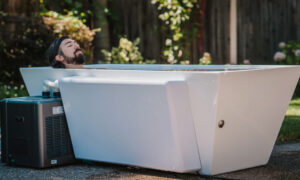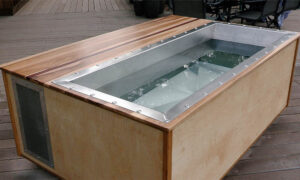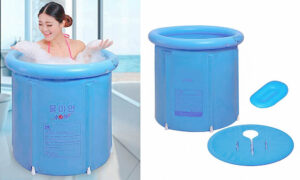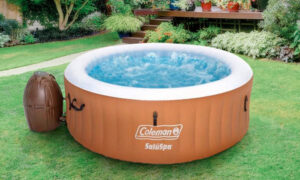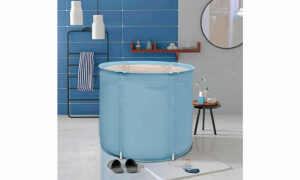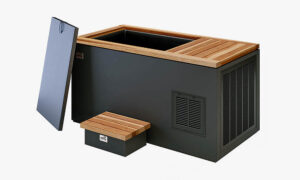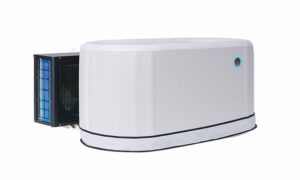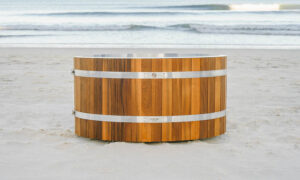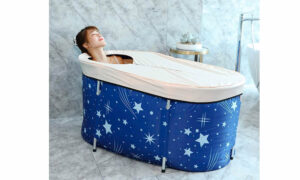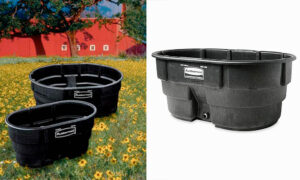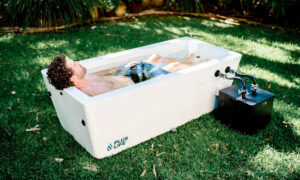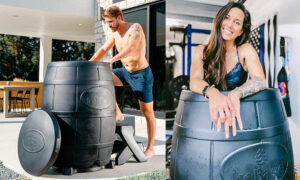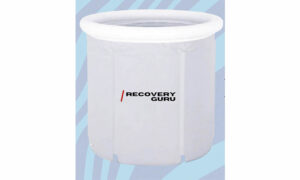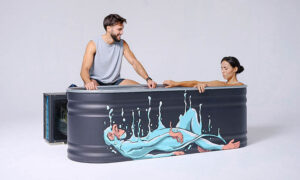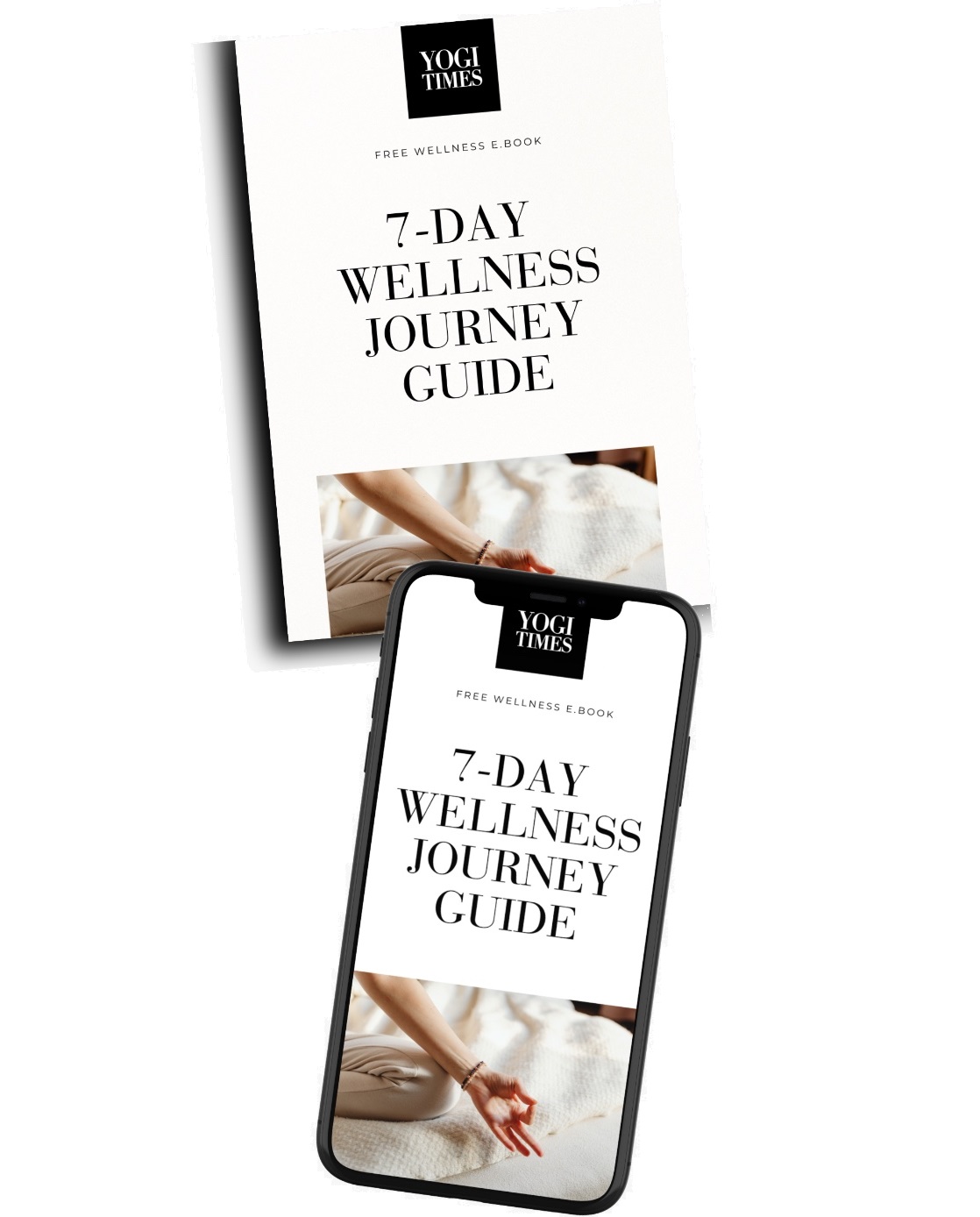Best Cold Plunge Tub & Ice Bath Tub for Home in 2025

An ice bath tub, also known as a cold plunge tub, is a specialized tub filled with cold water and used for brief immersion sessions. Ice baths are typically filled with water between 50 and 59 degrees Fahrenheit.
They are used for various purposes, including improving physical and mental well-being, reducing muscle soreness and inflammation, improving circulation, boosting the immune system, and reducing stress.
An ice bath tub can be made of various materials, such as plastic, acrylic, fiberglass, concrete, or stainless steel, and can have multiple features, such as jets, lighting, or a heating system.
An ice bath tub can be used indoors or outdoors and is either portable or permanently installed. It is important to be aware of the potential risks and to take proper precautions when using an ice bath tub.
The 17 best ice baths tubs of 2025
Here is a comparison table that lists these tubs in no particular order:
seats 1. standard 67” length
High range
~$5000 USD
Indoor/outdoor use.
Cold, or hot & cold tub available.
Lowest temperature 39F.
Blue Cube Baths – Mini Me
seats 1 up to 5’11
48” length
Very high range ~$16,000 USD
Indoor/outdoor use (if in the shade). Temperature between 36F-60F.
30” height
Low range ~$66 USD
Indoor/outdoor use.
Takes hot and cold water.
Portable when deflated.
63” length, 25 gallons
Low range ~$90 USD
Indoor/outdoor use.
Takes hot and cold water.
Wayfair – Coleman Saluspa Inflatable tubs
seats 2-4 people. 192 gallons.
Low to mid range ~$580 USD
Indoor/outdoor use.
Hot tub, cannot be used in temperatures less than 39F.
seats 1. tub 26” height
Low range ~$54 USD
Indoor/outdoor use.
Takes hot and cold water.
seats 1. 80 gallons. Tub 64” length
Very high range ~$9700 USD
Indoor/outdoor use.
seats 1
High range ~$3600 USD
Cold, or hot & cold tub available.
Temperature range 36F-101F.
Odin Ice Bath – Odin Plunge
seats 1, up to 6’2
High range ~$6900 USD
To be kept undercover and out of direct weather. Can fit through standard door.
Lowest temperature 32F.
seats 1, 44” length
Low range ~$90 USD
Indoor/outdoor use. Foldable. Highest temperature recommended is 113F
seats 1. 39” length. 150 gallons
Low to mid range ~$350 USD
Mostly for outdoor use.
seats 1-2 people. 68.5″ length
High range ~$5100 USD
Indoor/outdoor use. Lowest temperature 37F.
seats 1 person. 42″ height by 31″ wide. 105 gallons.
Mid-high range ~$1200 USD
Mostly for outdoor use. Lightweight and portable.
seats 1 person
Low range ~$220 USD
Portable and inflatable with support poles.
Polar Monkeys – The Portal
seats 1 person. 48″ or 72″ length. 170 gallons.
High range ~$2700 USD
Indoor/outdoor use. Temperature between 36F-101F.
Here are some short, descriptive reviews of the 17 best ice baths of 2023
Cold Plunge

Expensive, but it’s a high end product. No plumbing required, it just needs a 110V outlet. They have a maintenance guide on their website and the option to buy a 6 month maintenance package.
Unlike cheaper models, it includes cooling filtration, an underwater light, a filter to remove debris, an insulated spa cover, cell phone holder hose filter, skimmer net and even a rubber duck. The tub itself is fully insulated. This brand offers tubs with standard cooling speed or pro cooling speed.
Use Coupon Code YOGI to get 150 US$ off.
Blue Cube Baths – Mini Me

This tub has a 5 year warranty (on the frame) and includes an insulated spa cover. It is said to fill up in around 15 minutes, depending on water pressure and drains in a similar time.
There is a 20 micron filter and ozone, allowing for chemical free filtration for easy maintenance. It is recommended that the filters are washed every 2 weeks and the tub is drained at least once per month.
250 US$ off when using coupon code YOGITIMES
Inflatable Portable Bathtub

Good and durable, but the size runs small. It is easy to clean and can be inflated either manually or with a pump. It includes one water cushion and one bathtub cover, and there is a valve and piping system for easy drainage.
Hydraflate Inflatable Bathtub

Good, but appears to be somewhat cumbersome to inflate. It includes a zipper cover, inflatable bath cushion and an electric pump. There are dual drains and a tube attachment for drainage.
Wayfair – Coleman Saluspa Inflatable Cold Plunge Tub

Marketed as a hot tub, but has the capacity to withstand cold water. It seems easy to maintain and has a 6 month warranty. It includes a pump, massage jets, a built-in digital control panel for temperature, an insulated cover with safety locks, one repair patch and an Airjet system.
Portable Foldable Bathtub

Fairly good, but perhaps not the best choice for people with mobility issues. Easy to clean and moderately easy to set up, and it includes a water cushion.
Renu Therapy Cold Stoic

It is weatherproof and easy to clean, and has a filter system to reduce the need for chemicals, but there is an extra cost for maintenance items. It uses an integrated chiller and requires a 110V outlet.
There is a 5 year limited warranty available and the option to customize the look. It includes a step stool and an insulated lid.
Polar Monkeys Inflatable

This tub includes a 1 year warranty. There are accessories available separately, but purchasing this item will give you a drain valve, 1/2 HP water chiller, filter, hoses, inflating pump, and a tub cover.
Odin Cold Plunge Tub

This tub doesn’t require plumbing as it is a plug-in. It has a 5 year limited warranty, and includes an insulated, lockable spa lid. In terms of maintenance, it has a built-in filtration system that uses an ozone generator to sanitise water, however it is recommended that you clean the filter every 3-4 weeks and wipe the tub clean.
Foldable Bathtub

There are no accessories included with this tub. Maintenance appears to be easy with a wipe clean. It seems easy to set up, however draining the tub has been described as not so easy for some.
Rubbermaid stock tank

This is a plastic tub that is durable and weather resistant. It seems easy to maintain and includes an oversized drain for easy drainage.
Plus Life Health Cold Plunge Tub

It is a weatherproof tub with an ozone filter and UV light filtration, and the filters can last up to 6 months before you need to replace them. It has in-built cleaning and sanitation and comes with a one year manufacturer warranty and a waterproof, insulated cover. You can set the temperature on the chiller unit or by using the phone app.
Ice Barrel

It includes a lid, barrel stand, UV cover and a step stool. There is a limited lifetime warranty and an easy to use drainage system. Cold plunge maintenance kit available to buy.
Recovery Guru Inflatable Cold Plunge Tub

This is a simple tub and includes a foot pump to inflate.
Polar Monkeys – The Portal

It is a steel tank with inlet/outlet connections and it has a drain valve and a one year warranty. It does not include accessories such as an insulated cover and ozone generator, however it does include a pump, filter and hoses. It is described as easy to set up and is maintenance friendly. You can choose out of three colors, black, white or with limited edition artwork.

How we selected the best cold plunge tub
We looked at many factors, including the size and capacity of the tub, the materials used to make it, how easy it is to set up, its durability and maintenance requirements, and any additional features or accessories.
We have read reviews and testimonials from other users to get a sense of the performance and quality of different ice plunge tubs.
Then we compared the prices and considered the overall value of the tub in terms of its features, performance, and durability. Now that we have done the hard part, you can make an informed decision and choose the best ice plunge tub for you.
Benefits of a cold plunge tub
Ice bathing is a popular recovery method used by athletes and fitness enthusiasts to reduce muscle soreness and inflammation, improve circulation, and increase mental toughness. Some potential benefits of cold water therapy, supported by scientific evidence, include:
1. Reducing muscle soreness and inflammation: Cold water therapy can have physical benefits. It can help to reduce inflammation and muscle soreness after intense exercise.
This is because cold water causes blood vessels to constrict, which can help to reduce swelling and inflammation. A systematic review of studies found that cold water therapy may effectively minimize muscle soreness after exercise (Bleakley, McDonough, & MacAuley, 2004).
2. Improving circulation: cold plunges can also help to improve circulation by forcing blood to flow to the body’s core to keep the body warm. This can help flush out waste products and bring oxygen and nutrients to the muscles, aiding recovery.
A study found that cold plunges may increase muscle blood flow, enhancing recovery (Meeusen, Duclos, Foster, Fry, Gleeson, Nieman, Raglin, & Urhausen, 2006).
3. Enhancing mental toughness: Ice baths can also have mental health benefits. They can be an excellent way to build mental toughness and resilience. They can be uncomfortable and challenging, but the ability to tolerate and overcome that discomfort can help to build mental fortitude. A study found that cold plunges may positively affect psychological well-being, including reduced anxiety and improved mood (Sharwood, Collins, & Callister, 2015).
It’s important to note that ice baths may not be suitable for everyone, and it’s always a good idea to consult a healthcare provider before trying any new recovery method. In addition, it’s essential to use caution when taking ice baths, as extreme cold can be dangerous if not done correctly.

Things to consider before buying a cold plunge tub
When considering buying an ice bath, there are several factors that you should consider to ensure that you are getting the best product for your needs and budget. These include:
Size
Consider the size of the tub and the amount of space you have available for it. A larger tub may be more comfortable, but it will also take up more space and may be more expensive.
Material
Ice bathtubs can be made of various materials, such as plastic, acrylic, fiberglass, concrete, or stainless steel. Each material has its benefits and drawbacks, so consider the durability, cost, and maintenance requirements when deciding.
Features
Some cold plunge tubs may have additional features like jets, lighting, or a heating system. Consider which features are important to you and whether they are worth the extra cost.
Budget
Determine how much you are willing to spend on a cold plunge tub and look for options that meet your budget and needs.
Maintenance
Consider the maintenance requirements of the tub and whether you are willing and able to maintain it properly. Some tubs may require more frequent cleaning or upkeep.
After considering these factors, you can make an informed decision and choose the best ice bath for your home.
Are ice baths worth the investment?
There is limited scientific evidence on the effectiveness of ice baths for various purposes.
Some claim that ice baths can help reduce muscle soreness, inflammation, and fatigue after exercise, while others believe they can improve recovery and performance. However, there is not enough research to support these claims.
Cold water can be uncomfortable and even painful, and other, more proven methods of recovery and performance enhancement may be more effective. For example, stretching, foam rolling, and massage can help reduce muscle soreness and improve recovery.
If you are interested in trying an ice bath, it is important to consult with a healthcare professional first. They can assess your overall health and help determine if an ice bath is appropriate for you. Additionally, it is important to be careful when taking an ice bath and to ensure the water is not too cold and that you do not stay in the bath for too long.

FAQs
Can I cold plunge in a regular bathtub?
Yes, it’s possible to take a cold plunge in a bathtub. Ice bathing or cold therapy involves immersing the body in cold water for a brief period. This can be done in a dedicated cold plunge tub or a regular bathtub filled with cold water.
However, it is essential to be aware of the potential risks associated with cold immersion and to take proper precautions. It is recommended to gradually acclimatize the body to cold water by starting with lukewarm water and gradually decreasing the temperature.
How long should I stay in a cold plunge tub?
The recommended duration of a cold plunge session varies depending on the individual’s tolerance to cold and their specific health or fitness goals. Cold plunge sessions are typically brief, lasting from one to three minutes. It is essential to listen to your body and stop the session if you experience any discomfort or adverse reactions.
It is also important to note that spending time in ice bath tubs can have various health benefits, but it is only suitable for some. People with certain health conditions, such as asthma, Raynaud’s syndrome, or uncontrolled hypertension, should avoid going in an ice tub or consult a healthcare professional before trying it.
How much is an ice bath tub?
The cost of an ice bath tub can vary widely depending on the size, material, and features of the tub. Some ice bathtubs are designed for indoor use and can be installed in a dedicated room or a basement, while others are portable and can be used outdoors.
Here are some estimates of the cost of ice bathtubs based on various factors:
- A small, portable ice bathtub made of plastic can cost between $55 and $1000.
- A mid-sized indoor cold plunge tub made of acrylic or fiberglass can cost between $2000 and $5000.
- A large, custom cold plunge tub made of concrete or stainless steel can cost $10,000 or more.
Remember to consider your budget and the specific features that you are looking for when choosing a cold plunge tub. Some factors that may affect the cost include the size of the tub, the material it is made of, the type of insulation or heating system it has, and any additional features such as jets or lighting.

How do I turn my bathtub into a cold plunge?
Fill the bathtub with cold water using a hose or a bucket. The water should be between 50 and 59 degrees Fahrenheit.
Gradually acclimatize your body to the cold water by starting with lukewarm water and gradually decreasing the temperature. This will help reduce the shock of cold water and prevent any adverse reactions.
Once you are in the tub, take deep breaths and try to relax. Focus on your breathing and stay in the tub for one to three minutes.
If you experience discomfort or adverse reactions, such as shivering, dizziness, or numbness, get out of the tub immediately.
Are ice baths good for you?
Ice baths or cold plunge pools can have various health benefits when used appropriately. Time in an ice tub can help reduce muscle soreness and inflammation, improve circulation, stimulate the immune system, reduce stress, and improve mental clarity.
However, it is essential to note that ice baths are not suitable for everyone and can have potential risks. People with certain health conditions, such as asthma, Raynaud’s syndrome, or uncontrolled hypertension, should avoid ice baths or consult a healthcare professional before trying them. It is also essential to take proper precautions, such as gradually acclimating the body to the cold water and avoiding overstaying in the tub.
Ice baths are most effective as part of a well-rounded fitness and recovery routine. It is essential to listen to your body and stop the ice bath session if you experience any discomfort or adverse reactions.

What are the disadvantages of ice baths?
While ice baths can have various health benefits when used appropriately, there are also potential disadvantages. Some of the potential drawbacks of ice baths include the following:
Risk of injury
Time in a cold tub can cause the blood vessels in the skin to constrict, increasing the risk of injury if the immersion is too long or the water is too cold.
Adverse reactions
Some people may experience adverse reactions to being in a cold tub, such as shivering, dizziness, or numbness. It is vital to stop the session if you experience any of these symptoms.
Inconvenience
Ice baths can be inconvenient for some people, as they require a dedicated tub and cold water, which may need to be more readily available.
Unsuitable for specific health conditions
Ice baths are not suitable for everyone and can have potential risks. People with certain health conditions, such as asthma, Raynaud’s syndrome, or uncontrolled hypertension, should avoid ice baths or consult a healthcare professional before trying them.
Time and effort
It can be time-consuming and require effort, as the body must gradually acclimate to the cold water.
Overall, it is essential to consider ice baths’ potential disadvantages and take proper precautions when using them.
How many ice baths a week should I take
The recommended frequency of ice baths, also known as a cold immersion or cold plunging, varies depending on the individual’s tolerance to cold and the specific health or fitness goals being pursued. An ice bath is most effective as part of a well-rounded fitness and recovery routine.
Here are some general guidelines for the frequency of ice baths:
- Instead of a daily routine, one to two ice baths per week may be sufficient for athletes or anyone looking to improve recovery after a workout.
- For general health and well-being, taking an ice bath once or twice a month may be sufficient.
Listening to your body and adjusting how often you take an ice bath is essential based on your tolerance and needs.
Why do I feel tired after a cold bath plunge?
There are several reasons why you might be feeling tired after ice bathing. One possible explanation is that the extremely cold temperature of the water is causing your body to use more energy to maintain its average body temperature, which can lead to feeling fatiugued
Cold water therapy may also cause blood vessels to constrict, which can reduce blood flow to the muscles and other tissues, leading to feelings of tiredness.
Additionally, the physical stress of immersing your body in cold water and the mental stress of tolerating the discomfort may also contribute to feelings of fatigue.
It is also possible that other factors, such as your overall level of physical activity, diet, and sleep, may be contributing to your fatigue.
If you are concerned about feeling tired after a cold plunge bath, it is recommended to speak with a healthcare provider for further evaluation and guidance.

How much ice should there be in a cold plunge tub?
An ice bath is typically filled with cold water, so you may not need to buy ice. The best ice bath tubs have water that is between 50 and 59 degrees Fahrenheit, or 10° to 15° Celsius.
If you want to add ice to an ice bath to lower the water temperature, you can combine cold water and ice. Remember to avoid overstaying in the tub and to monitor the temperature of the water to ensure that it’s not too cold.
Wim Hof ice baths
The Wim Hof Method is a holistic approach to health and well-being that includes cold immersion, also known as an ice bath. The Wim Hof Method was developed by Wim Hof, a Dutch extreme athlete and self-proclaimed “Iceman,” known for his ability to withstand extreme cold.
His method involves cold exposure, breathing techniques, and commitment. Cold exposure, including ice baths, is one of the pillars of the Wim Hof Method and is believed to have a range of health benefits, including improved immune function, reduced inflammation, and better mood.
To do an ice bath as part of the Wim Hof Method, you will need to follow these steps:
1. Fill a bathtub or a large container with cold water using a hose or a bucket. The water should be between 50 and 59 degrees Fahrenheit (10° to 15° Celsius)
2. Gradually acclimatize your body to the cold water by starting with lukewarm water and gradually decreasing the temperature. This will help reduce the shock of cold water and prevent any adverse reactions.
3. Once you are in the tub, take deep breaths and try to relax. Focus on your breathing and stay in the tub for one to three minutes.
4. If you experience discomfort or adverse reactions, such as shivering, dizziness, or numbness, get out of the tub.
Cold shower vs. ice bath
A cold shower might feel good, and you may still benefit from it; however, it won’t lower your core body temperature in the same way an ice bath would.
In conclusion
Cold plunge tubs can be a valuable tool for athletes and fitness enthusiasts looking to improve physical and mental well-being, reduce muscle soreness and inflammation, improve circulation, boost the immune system, and reduce stress. It is essential to be aware of the potential risks and to take proper precautions when using a cold plunge tub.
Remember to consider factors such as size, material, features, and price. What we believe to be the 18 best cold plunge tubs of 2023 include a range of options to meet the needs of various individuals and budgets.
It is recommended to consult with a healthcare provider before trying any new recovery method and to use caution when taking ice baths to ensure safety.
References (cold plunge tub article)
Bleakley, C., McDonough, S., & MacAuley, D. (2004). The use of ice in the treatment of acute soft-tissue injury: a systematic review of randomized controlled trials. American Journal of Sports Medicine, 32(1), 251-261.
Cheung, K., Hume, P. A., & Maxwell, L. (2003). Delayed onset muscle soreness: treatment strategies and performance factors. Sports Medicine, 33(2), 145-164.
Edmonds, J., Jeffries, O., & Smith, P. (2011). Cold-water immersion and recovery from strenuous exercise: a meta-analysis. Journal of Athletic Training, 46(2), 220-229.
Halson, S. L., Jeukendrup, A. E., & Martin, D. T. (2014). Can athletes use cold water immersion to aid recovery after training? Sports Medicine, 44(6), 879-890.
Johnston, J. D., & Jenkins, D. G. (2006). Cold water immersion and exercise-induced muscle damage. Medicine and Science in Sports and Exercise, 38(5), S488.
Meeusen, R., Duclos, M., Foster, C., Fry, A., Gleeson, M., Nieman, D., Raglin, J., & Urhausen, A. (2006). Prevention, diagnosis, and treatment of the overtraining syndrome. Medicine and Science in Sports and Exercise, 38(11), 1964-1970.
Sharwood, K., Collins, M., & Callister, R. (2015). The effects of cold water immersion on muscle soreness and other aspects of recovery following strenuous exercise: a systematic review. British Journal of Sports Medicine, 49(17), 1163-1173.
Yeung, E. W., & Yeung, S. S. (2012). Cold water immersion and recovery from exercise-induced muscle damage: a meta-analysis. Journal of Science and Medicine in Sport, 15(5), 391-396.
FAQs
A cold plunge tub, also known as an ice bathtub, is a specialized tub filled with cold water, typically between 50 and 59 degrees Fahrenheit, used for brief immersion sessions to improve physical and mental well-being.
Benefits include reducing muscle soreness and inflammation, improving circulation, boosting the immune system, and reducing stress.
Prices vary widely based on size, material, and features. They can range from as low as $66 for a basic inflatable model to over $16,000 for high-end models with advanced features.
Yes, you can use a regular bathtub for cold plunging by filling it with cold water. However, specialized cold plunge tubs may offer better temperature control and features.
Hydrogen water bottles effectively infuse water with molecular hydrogen, providing various health benefits.
Sessions are typically brief, lasting from one to three minutes, depending on individual tolerance and health or fitness goals.
While beneficial, cold plunging can pose risks, such as injury from prolonged exposure and adverse reactions like shivering or dizziness, and is unsuitable for certain health conditions. Consult a healthcare provider before starting.
The frequency can vary based on personal goals and tolerance. For recovery purposes, one to two times per week may be sufficient. Always listen to your body and adjust accordingly.
Feeling tired after a cold plunge can result from the body using more energy to maintain its temperature, reduced blood flow to muscles, and the physical and mental stress of cold exposure.
Consider size, material, features, budget, and maintenance requirements to ensure the tub meets your needs and preferences.
While ice baths can offer several health benefits, their effectiveness varies by individual and may not be suitable for everyone. Consider other recovery methods and consult with a healthcare professional.
